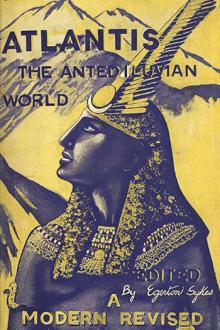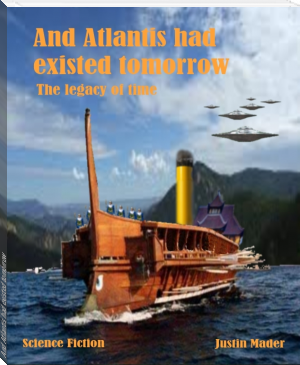Atlantis: The Antedeluvian World by Ignatius Donnelly (thriller novels to read .TXT) 📕

- Author: Ignatius Donnelly
- Performer: -
Book online «Atlantis: The Antedeluvian World by Ignatius Donnelly (thriller novels to read .TXT) 📕». Author Ignatius Donnelly
Civilization is not communicable to all; many savage tribes are incapable of it. There are two great divisions of mankind, the civilized and the savage; and, as we shall show, every civilized race in the world has had something of civilization from the earliest ages; and as “all roads lead to Rome,” so all the converging lines of civilization lead to Atlantis. The abyss between the civilized man and the savage is simply incalculable; it represents not alone a difference in arts and methods of life, but in the mental constitution, the instincts, and the predispositions of the soul. The child of the civilized races in his sports manufactures water-wheels, wagons, and houses of cobs; the savage boy amuses himself with bows and arrows: the one belongs to a building and creating race; the other to a wild, hunting stock. This abyss between savagery and civilization has never been passed by any nation through its own original force, and without external influences, during the Historic Period; those who were savages at the dawn of history are savages still; barbarian slaves may have been taught something of the arts of their masters, and conquered races have shared some of the advantages possessed by their conquerors; but we will seek in vain for any example of a savage people developing civilization of and among themselves. I may be reminded of the Gauls, Goths, and Britons; but these were not savages, they possessed written languages, poetry, oratory, and history; they were controlled by religious ideas; they believed in God and the immortality of the soul, and in a state of rewards and punishments after death. Wherever the Romans came in contact with Gauls, or Britons, or German tribes, they found them armed with weapons of iron. The Scots, according to Tacitus, used chariots and iron swords in the battle of the Grampians—“enormes gladii sine mucrone.”
The Celts of Gaul are stated by Diodorus Siculus to have used iron-headed spears and coats-of-mail, and the Gauls who encountered the Roman arms in B.C. 222 were armed with soft iron swords, as well as at the time when Caesar conquered their country. Among the Gauls men would lend money to be repaid in the next world, and, we need not add, that no Christian people has yet reached that sublime height of faith; they cultivated the ground, built houses and walled towns, wove cloth, and employed wheeled vehicles; they possessed nearly all the cereals and domestic animals we have, and they wrought in iron, bronze, and steel.
The Gauls had even invented a machine on wheels to cut their grain, thus anticipating our reapers and mowers by two thousand years. The difference between the civilization of the Romans under Julius Caesar and the Gauls under Vercingetorix was a difference in degree and not in kind. The Roman civilization was simply a development and perfection of the civilization possessed by all the European populations; it was drawn from the common fountain of Atlantis.
If we find on both sides of the Atlantic precisely the same arts, sciences, religious beliefs, habits, customs, and traditions, it is absurd to say that the peoples of the two continents arrived separately, by precisely the same steps, at precisely the same ends. When we consider the resemblance of the civilizations of the Mediterranean nations to one another, no man is silly enough to pretend that Rome, Greece, Egypt, Assyria, Phœnicia, each spontaneously and separately invented the arts, sciences, habits, and opinions in which they agreed; but we proceed to trace out the thread of descent or connection from one to another. Why should a rule of interpretation prevail, as between the two sides of the Atlantic, different from that which holds good as to the two sides of the Mediterranean Sea? If, in the one case, similarity of origin has unquestionably produced similarity of arts, customs, and condition, why, in the other, should not similarity of arts, customs, and condition prove similarity of origin? Is there any instance in the world of two peoples, without knowledge of or intercourse with each other, happening upon the same invention, whether that invention be an arrow-head or a steam-engine? If it required of mankind a lapse of at least six thousand years before it began anew the work of invention, and took up the thread of original thought where Atlantis dropped it, what probability is there of three or four separate nations all advancing at the same speed to precisely the same arts and opinions? The proposition is untenable.
If, then, we prove that, on both sides of the Atlantic, civilizations were found substantially identical, we have demonstrated that they must have descended one from the other, or have radiated from some common source.
CHAPTER II
THE IDENTITY OF THE CIVILIZATIONS OF THE OLD WORLD AND THE NEW
MOSAICS AT MITLA, MEXICOArchitecture.—Plato tells us that the Atlanteans possessed architecture; that they built walls, temples, and palaces.
We need not add that this art was found in Egypt and all the civilized countries of Europe, as well as in Peru, Mexico, and Central America.
Among both the Peruvians and Egyptians the walls receded inward, and the doors were narrower at, the top than at the threshold.
The obelisks of Egypt, covered with hieroglyphics, are paralleled by the round columns of Central America, and both are supposed to have originated in Phallus-worship. “The usual symbol of the Phallus was an erect stone, often in its rough state, sometimes sculptured.” (Squier, “Serpent Symbol,” p. 49; Bancroft’s “Native Races,” vol. iii., p. 504.) The worship of Priapus was found in Asia, Egypt, along the European shore of the Mediterranean, and in the forests of Central America.
The mounds of Europe and Asia were made in the same way and for the same purposes as those of America. Herodotus describes the burial of a Scythian king; he says, “After this they set to work to raise a vast mound above the grave, all of them vying with each other, and seeking to make it as tall as possible.” “It must be confessed,” says Foster (“Prehistoric Races,” p. 193), “that these Scythic burial rites have a strong resemblance to those of the Mound Builders.” Homer describes the erection of a great symmetrical mound over Achilles, also one over Hector. Alexander the Great raised a great mound over his friend Hephæstion, at a cost of more than a million dollars; and Semiramis raised a similar mound over her husband. The pyramids of Egypt, Assyria, and Phœnicia had their duplicates in Mexico and Central America.
CARVING ON THE BUDDHIST TOWER, SARNATH, INDIA The grave-cists made of stone of the American mounds are exactly like the stone chests, or kistvaen for the dead, found in the British mounds.(Fosters “Prehistoric Races,” p. 109.) Tumuli have been found in Yorkshire enclosing wooden coffins, precisely as in the mounds of the Mississippi Valley. (Ibid., p. 185.) The articles associated with the dead are the same in both continents: arms, trinkets, food, clothes, and funeral urns. In both the Mississippi Valley and among the Chaldeans vases were constructed around the bones, the neck of the vase being too small to permit the extraction of the skull. (Foster’s “Prehistoric Races,” p. 200.)
The use of cement was known alike to the European and American nations.
The use of the arch was known on both sides of the Atlantic.
The manufacture of bricks was known in both the Old and New Worlds.
The style of ornamentation in architecture was much the same on both hemispheres, as shown in the preceding designs, pages 137, 139.
Metallurgy.—The Atlanteans mined ores, and worked in metals; they used copper, tin, bronze, gold, and silver, and probably iron.
The American nations possessed all these metals. The age of bronze, or of copper combined with tin, was preceded in America, and nowhere else, by a simpler age of copper; and, therefore, the working of metals probably originated in America, or in some region to which it was tributary. The Mexicans manufactured bronze, and the Incas mined iron near Lake Titicaca; and the civilization of this latter region, as we will show, probably dated back to Atlantean times. The Peruvians called gold the tears of the sun: it was sacred to, the sun, as silver was to the moon.
Sculpture.—The Atlanteans possessed this art; so did the American and Mediterranean nations.
Dr. Arthur Schott (“Smith. Rep.,” 1869, p. 391), in describing the “Cara Gigantesca,” or gigantic face, a monument of Yzamal, in Yucatan, says, “Behind and on both sides, from under the mitre, a short veil falls upon the shoulders, so as to protect the back of the head and the neck. This particular appendage vividly calls to mind the same feature in the symbolic adornments of Egyptian and Hindoo priests, and even those of the Hebrew hierarchy.” Dr. Schott sees in the orbicular wheel-like plates of this statue the wheel symbol of Kronos and Saturn; and, in turn, it may be supposed that the wheel of Kronos was simply the cross of Atlantis, surrounded by its encircling ring.
Painting.—This art was known on both sides of the Atlantic. The paintings upon the walls of some of the temples of Central America reveal a state of the art as high as that of Egypt.
Engraving.—Plato tells us that the Atlanteans engraved upon pillars.
The American nations also had this art in common with Egypt, Phœnicia, and Assyria.
Agriculture.—The people of Atlantis were pre-eminently an agricultural people; so were the civilized nations of America and the Egyptians. In Egypt the king put his hand to the plough at an annual festival, thus dignifying and consecrating the occupation of husbandry. In Peru precisely the same custom prevailed. In both the plough was known; in Egypt it was drawn by oxen, and in Peru by men. It was drawn by men in the North of Europe down to a comparatively recent period.
Public Works.—The American nations built public works as great as or greater than any known in Europe. The Peruvians had public roads, one thousand five hundred to two thousand miles long, made so thoroughly as to elicit the astonishment of the Spaniards. At every few miles taverns or hotels were established for the accommodation of travellers. Humboldt pronounced these Peruvian roads “among the most useful and stupendous works ever executed by man.” They built aqueducts for purposes of irrigation some of which were five hundred miles long. They constructed magnificent bridges of stone, and had even invented suspension bridges thousands of years before they were introduced into Europe. They had, both in Peru and Mexico, a system of posts, by means of which news was transmitted hundreds of miles in a day, precisely like those known among the Persians in the time of Herodotus, and subsequently among the Romans. Stones similar to mile-stones were placed along the roads in Peru. (See Prescott’s “Peru,”)
Navigation.—Sailing vessels were known to the Peruvians and the Central Americans. Columbus met, in 1502, at an island near Honduras, a party of the Mayas in a large vessel, equipped with sails, and loaded with a variety of textile fabrics of divers colors.
ANCIENT IRISH VASE OF THE BRONZE AGEManufactures.—The American nations manufactured woollen and cotton goods; they made pottery as beautiful as the wares of





Comments (0)